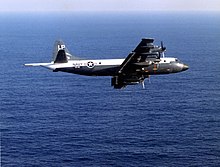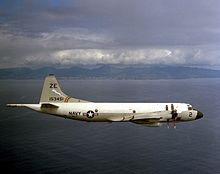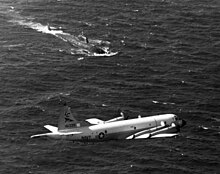
The Boeing E-3 Sentry is an American airborne early warning and control (AEW&C) aircraft developed by Boeing. E-3s are commonly known as AWACS. Derived from the Boeing 707 airliner, it provides all-weather surveillance, command, control, and communications, and is used by the United States Air Force, NATO, French Air and Space Force, Royal Saudi Air Force and Chilean Air Force. The E-3 has a distinctive rotating radar dome (rotodome) above the fuselage. Production ended in 1992 after 68 aircraft had been built.

The Lockheed S-3 Viking is a four-crew, twin-engine turbofan-powered jet aircraft designed and produced by the American aerospace manufacturer Lockheed Corporation. Because of its characteristic sound, it was nicknamed the "War Hoover" after the vacuum cleaner brand.

The Sikorsky SH-3 Sea King is an American twin-engined anti-submarine warfare (ASW) helicopter designed and built by Sikorsky Aircraft. A landmark design, it was one of the first ASW rotorcraft to use turboshaft engines.

The Lockheed P-3 Orion is a four-engined, turboprop anti-submarine and maritime surveillance aircraft developed for the United States Navy and introduced in the 1960s. Lockheed based it on the L-188 Electra commercial airliner; it is easily distinguished from the Electra by its distinctive tail stinger or "MAD" boom, used for the magnetic anomaly detection (MAD) of submarines.

The Lockheed EP-3 is an electronic signals reconnaissance variant of the P-3 Orion, primarily operated by the United States Navy.

The Douglas A-3 Skywarrior is a jet-powered strategic bomber that was developed and produced by the Douglas Aircraft Company. It was designed by Douglas on behalf of the United States Navy, which sought a carrier-capable strategic bomber. In July 1949, Douglas was awarded the contract to produce its design, having bested eight other aircraft companies' submissions. Unlike rival designs, which had aimed for a 100,000 lb (45,000 kg) maximum take-off weight, the Skywarrior was developed for a 68,000 lb (31,000 kg) take-off weight, facilitating its use from the navy's existing Midway-class aircraft carriers. Large portions of the aircraft were produced by the Westinghouse Electric Corporation, including its early Westinghouse J40 turbojet engines, which failed to meet promises and were replaced by the rival Pratt & Whitney J57 engine by mid-1953. On 28 October 1952, the prototype XA3D-1 performed the type's maiden flight.

The Lockheed P-2 Neptune is a maritime patrol and anti-submarine warfare (ASW) aircraft. It was developed for the US Navy by Lockheed to replace the Lockheed PV-1 Ventura and PV-2 Harpoon, and was replaced in turn by the Lockheed P-3 Orion. Designed as a land-based aircraft, the Neptune never made a carrier landing, but a small number were converted and deployed as carrier-launched, stop-gap nuclear bombers that would have to land on shore or ditch. The type was successful in export, and saw service with several armed forces.

The Lockheed EC-121 Warning Star was an American airborne early warning and control radar surveillance aircraft operational in the 1950s in both the United States Navy (USN) and United States Air Force (USAF).
A naval flight officer (NFO) is a commissioned officer in the United States Navy or United States Marine Corps who specializes in airborne weapons and sensor systems. NFOs are not pilots (naval aviators), but they may perform many "co-pilot" or "mission specialist" functions, depending on the type of aircraft. Until 1966, their duties were performed by both commissioned officer and senior enlisted naval aviation observers (NAO).

The Lockheed AP-3C Orion is a variant of the P-3 Orion used by the Royal Australian Air Force (RAAF) for tasks such as naval fleet support, maritime surveillance, search and survivor supply and anti-surface and anti-submarine warfare. The 18 AP-3C Orions were upgraded from P-3Cs between 1997 and 2005, with the program taking three years longer than expected due to systems integration problems. All 18 AP-3C Orions are operated by No. 92 Wing which is based at RAAF Base Edinburgh in South Australia. Aircraft from the wing have seen service as part of Australian Defence Force operations in Australia, South East Asia and the Middle East.

The Miles M.3 Falcon is a 1930s British three/four-seat cabin monoplane aircraft designed by Miles Aircraft Limited.
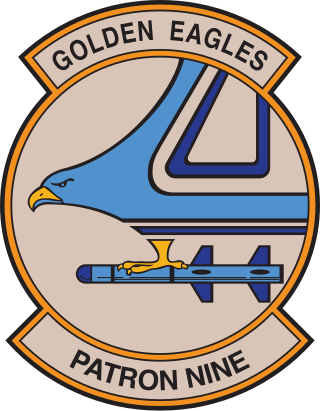
Patrol Squadron 9 (VP-9) is a U.S. Navy patrol squadron with its homeport located at Naval Air Station Whidbey Island. As of 2018, VP-9 is part of Patrol and Reconnaissance Wing Ten, Commander, Naval Air Forces, Pacific.

Air Test and Evaluation Squadron 30, nicknamed The Bloodhounds) is a United States Navy air test and evaluation squadron based at Naval Air Station Point Mugu, California. Using the tail code BH, the squadron flies the E-2D Hawkeye, Lockheed P-3 Orion, Gulfstream NC-20G, and the Lockheed C-130 Hercules aircraft. The VX-30 Bloodhounds provide support to the United States Navy's Sea Test Range off the shores of central California.
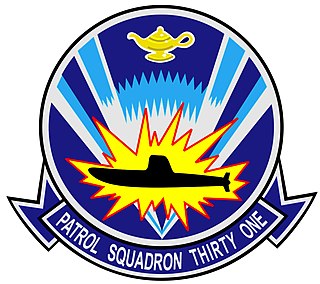
VP-31, Patrol Squadron 31 was a maritime patrol squadron of the United States Navy. It was established on 30 June 1960 to train replacement aircrew and maintenance personnel. It was disestablished on 1 November 1993.

Fleet Logistics Support Squadron 64 (VR-64), nicknamed the Condors, is a logistics squadron of the U.S. Navy Reserve, based at the Fort Dix entity of Joint Base McGuire–Dix–Lakehurst. The squadron was established as Patrol Squadron 64 (VP-64) on 1 November 1970 and redesignated on 18 September 2004, after 34 years of service. It was based at NAS Willow Grove, Pennsylvania until it was transferred to the Fort Dix element of Joint Base McGuire–Dix–Lakehurst in 2011. Units of the squadron made 26 major overseas deployments.
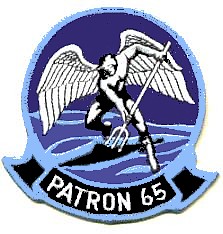
VP-65, nicknamed the Tridents, was a Patrol Squadron of the U.S. Navy Reserve. The squadron was established on 16 November 1970 at NAS Los Alamitos, California, and moved on 6 January 1971 to NAS Point Mugu. It was disestablished on 4 March 2006, after 35 years of service. Elements of the squadron made 22 major overseas deployments.

VP-66 was a patrol squadron of the U.S. Navy Reserve. The squadron was established on 1 November 1970 at NAS Willow Grove, Pennsylvania, where it was based for the rest of its life. It was disestablished on 31 March 2006, after 25 years of service. The squadron's nicknames were the Flying Sixes from 1971 to 1974, the Dicemen from 1975 to 1980, and the Liberty Bells from 1981 onward. Elements of the squadron made 19 major overseas deployments.

VP-68 was a Patrol Squadron of the U.S. Navy Reserve. The squadron was established on 1 November 1970 at NAS Patuxent River, Maryland. Its home port moved to Naval Air Facility Washington in 1985. The squadron was disestablished on 16 January 1997, after 26 years of service. Its nickname was the Blackhawks from 1972 onward. Elements of the squadron made 28 major overseas deployments.

Patrol Squadron 30 (VP-30) is a maritime patrol squadron of the United States Navy, established on 30 June 1960. It is based at Naval Air Station Jacksonville, Florida.
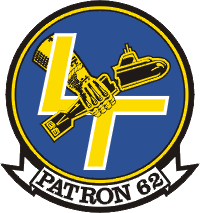
Patrol Squadron SIXTY TWO (VP-62) is a combat aviation squadron of the United States Navy Reserve. Since 31 July 2015, the squadron has been assigned to Commander, Maritime Support Wing, an Echelon IV organization under the Commander, Naval Air Force Reserve. Nicknamed the Broadarrows, the squadron flies the P-8 Poseidon maritime patrol aircraft from its home station of Naval Air Station Jacksonville, Florida, deploying worldwide. The squadron's aircraft can be identified by the stylized letters "LT" on the vertical stabilizer, the letter "L" being common to all U.S. Atlantic Fleet patrol aircraft, either Regular Navy or Navy Reserve, and the letter "T" being unique to VP-62. The stylized "LT" is also incorporated in the squadron's insignia as worn as a cloth patch on flight suits and flight jackets.

